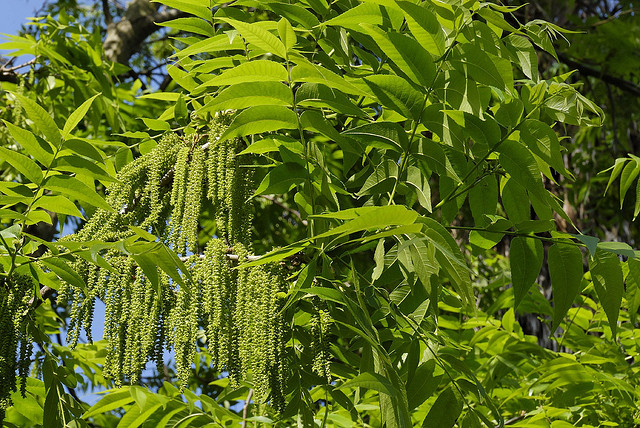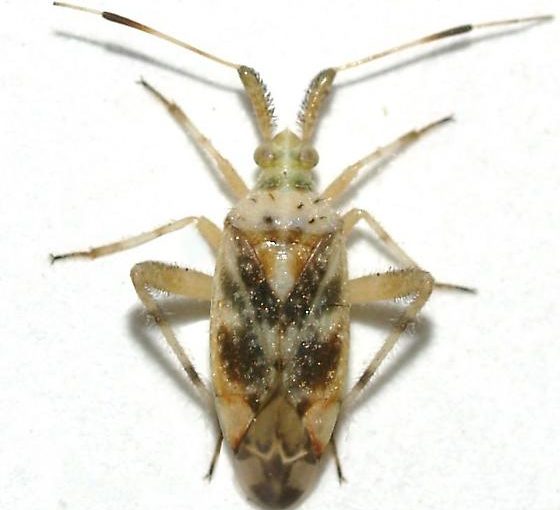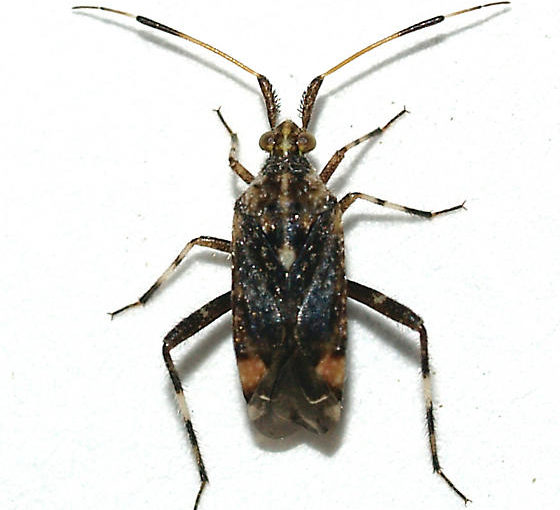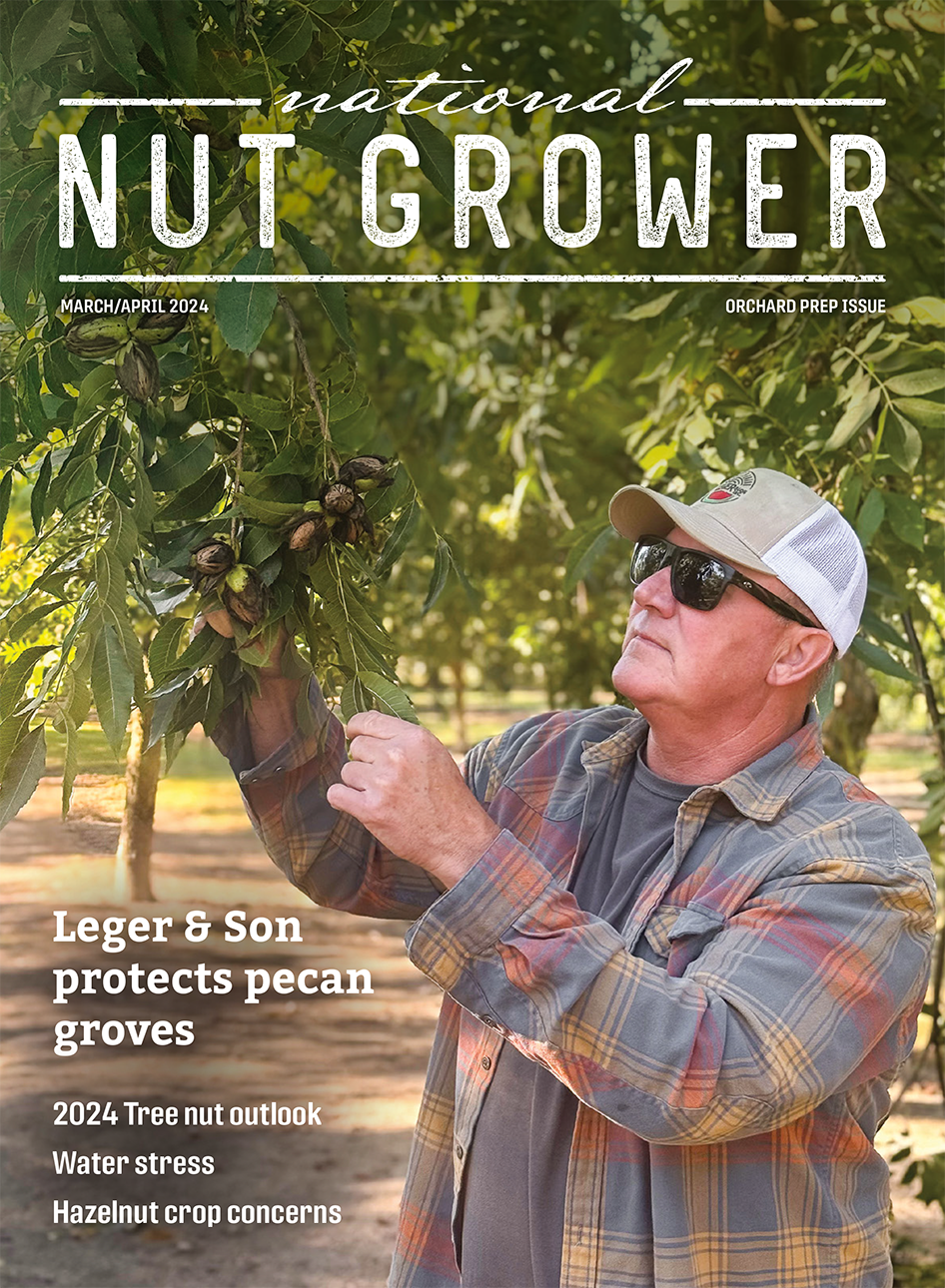
May 6, 2021Genus Neurocolpus, potential pest of Arizona pecans, brings concerns
A mirid plant bug has been observed in high numbers on the catkins of some central Arizona pecan orchards. Multiple growers report this for the first time and have expressed concerns about potential impacts to the crop.
This rapid communication is designed to provide the limited knowledge we have about this potential pest. Growers are encouraged to review this information with their pest control advisor to determine what action, if any, is required.

1) What is this bug? The insect appears to be a species of clouded plant bug in the genus Neurocolpus. There are multiple species of Neurocolpus in the western U.S., including the buckeye bug, N. longirostris, that is a known pest of pistachios in California. Several species of Neurocolpus occur in Arizona, each with thickened first segments of their antennae. Those in pecans are superficially similar in size and shape to a Lygus bug. They even have a pale-colored, heart-shaped scutellum on their back, similar to a Lygus bug. The first segment of the antenna in our recently collected specimens from Arizona, shown below, have thicker tips and the hind tibiae lack a medial stripe.
2) Are these bugs damaging pecans? These bugs have been concentrated on the catkins, where it is presumed that they are feeding. While this has the potential to reduce the amount of pollen, it is unlikely that the reductions would be so significant as to reduce yield. The primary concern is that these bugs may move from the catkins to young nuts, as occurs in pistachios in California, where probing of young fruit before the shell hardens causes young nuts to abort. In California, Neurocolpus has never been shown to cause damage to almonds, walnuts or pecans, and is not included in the UC Pest Management Guidelines for any of these three crops.
All three crops are grown in close proximity to pistachio orchards, including along the foothills of the Central Valley where California buckeye trees serve as a native host for N. longirostris. We are uncertain if the bugs being found on catkins will shortly become irrelevant to pecan growers, or if Arizona’s experience will be closer to that of pistachios in California. For that reason, growers should make close observations in the orchard, particularly as young nuts form.

3) What to look for? In California, PCAs monitor young nuts with a beat sheet. Look for bugs and aborted nutlets. Inspect the nutlets closely. If aborted due to feeding by Neurocolpus, you should see a dark spot where the insect’s mouthparts were inserted, and a sunken area on the surface of the fruit. These feeding marks are critical in distinguishing nuts that drop due to insects as compared to natural shed. In pistachios, PCAs watch the level of nut drop closely, because pistachios naturally set many more nuts than they can retain. Even low to moderate amounts of aborted nuts very early in the season are of little concern, because the tree naturally retains sufficient nuts that are healthy. Once the shells harden, small bugs like Neurocolpus are of no concern. The presence of a shell and hull on almonds, and a husk on walnuts, is likely why these crops are not injured.
Thus far, PCAs have been reporting these insects in central Arizona, primarily on Bradley, Western and Wichita varieties. Distribution in the field has been patchy, which is common for migratory insects that move into an orchard. In California, the greatest problems with small bugs like Neurocolpus occur when orchards are near native host plants that harbor the pest, or where the bugs are established in a cover crop or other ground cover that is accidentally mowed at the exact same time that small nuts are susceptible.
4) What to do about them? Is spraying necessary? There is no easy answer here. If treatments are needed, standard practice in California pistachios is to apply a pyrethroid. See the link to University of California’s guide given below. Permethrin has a very short residual but gives knockdown control of buckeye bug in pistachio. Bifenthrin or lambda-cyhalothrin provide longer residual control useful in addressing continued immigration but at greater risks to biological control. As a mirid, we can also consider what we know about a sister species in cotton, Lygus hesperus. In cotton, Carbine and Transform are the most popular control agents. Both are labeled for use in pecans – observe label restrictions carefully. However, we simply cannot be certain what level of control is possible, if any, with either product. Transform has done well in controlling other plant bug species the size of Lygus or smaller, including evidence of control of the clouded plant bug, N. nubilus, in cotton in Tennessee.
The benefit of using a more selective option is their safety to natural enemies and pollinators. These two products are also useful in aphid control. The pyrethroids are broad spectrum and this early season use could harm beneficials, which might set-up the grower for later problems including the flaring of pecan aphids.
Integrated pest management in any crop requires efforts to properly identify pests and levels of damage they are causing, coupled with consideration of any potential negative impacts on biological control, pollinators and the environment, before spraying. Because much of this information is still under development, PCAs are advised to make careful observations, compare notes with neighbors, and share information on this evolving issue. This is not an easy decision for a grower to make, but should be done with full understanding of what is at risk for each material and for doing nothing at all.
– Peter C. Ellsworth, Naomi Pier, W. Eugene Hall, University of Arizona, and David Haviland, University of California Kern Co. Cooperative Extension
Photo at top: Pecan tree catkins. Photo: University of Georgia







